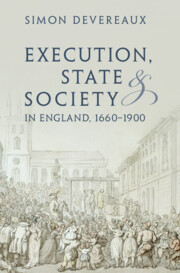Book contents
- Execution, State and Society in England, 1660–1900
- Series page
- Execution, State and Society in England, 1660–1900
- Copyright page
- Dedication
- Contents
- Figures
- Images
- Tables
- Acknowledgments
- Abbreviations
- 1 Introduction
- 2 Executions for Treason, 1660–1820
- 3 Changing Cultures of Execution: Religion and Feeling, 1660–1770
- 4 Changing Cultures of Execution: Reason and Reforms, 1770–1808
- 5 The Murder Act: Anatomization, 1752–1832
- 6 The Murder Act: Hanging in Chains, 1660–1834
- 7 The “Bloody Code” Debated, 1808–1821
- 8 The “Bloody Code” Diminished, 1822–1830
- 9 The Vicissitudes of Public Execution, 1830–1900
- 10 Conclusion
- Archival and Digital Sources
- Index
10 - Conclusion
Published online by Cambridge University Press: 12 October 2023
- Execution, State and Society in England, 1660–1900
- Series page
- Execution, State and Society in England, 1660–1900
- Copyright page
- Dedication
- Contents
- Figures
- Images
- Tables
- Acknowledgments
- Abbreviations
- 1 Introduction
- 2 Executions for Treason, 1660–1820
- 3 Changing Cultures of Execution: Religion and Feeling, 1660–1770
- 4 Changing Cultures of Execution: Reason and Reforms, 1770–1808
- 5 The Murder Act: Anatomization, 1752–1832
- 6 The Murder Act: Hanging in Chains, 1660–1834
- 7 The “Bloody Code” Debated, 1808–1821
- 8 The “Bloody Code” Diminished, 1822–1830
- 9 The Vicissitudes of Public Execution, 1830–1900
- 10 Conclusion
- Archival and Digital Sources
- Index
Summary
The transition from one culture of governance to another explains the character and timing of changes in the nature, location and scale of English executions from 1660 to 1900. Traditional landed elites adhered both to a “Bloody Code,” whose enforcement against common criminals could be regularly adjusted through consultations between trial judges and themselves, and to the occasional use of prolongedly agonizing execution rituals against traitors. The men who dominated England’s uniquely extensive and steadily expanding urban realms, and embraced new cultures of desacralization, feeling and reason, increasingly viewed the purposes, numerical extent and staging of executions differently. As the numbers and power of urbane people grew, first the extent and finally the practices of execution were adjusted accordingly. The many paradoxes of “feeling”, however, ensured their continued commitment to execution for murder, and some measure of hypocrisy in their views of executions and the people who attended them.
- Type
- Chapter
- Information
- Execution, State and Society in England, 1660–1900 , pp. 367 - 378Publisher: Cambridge University PressPrint publication year: 2023

